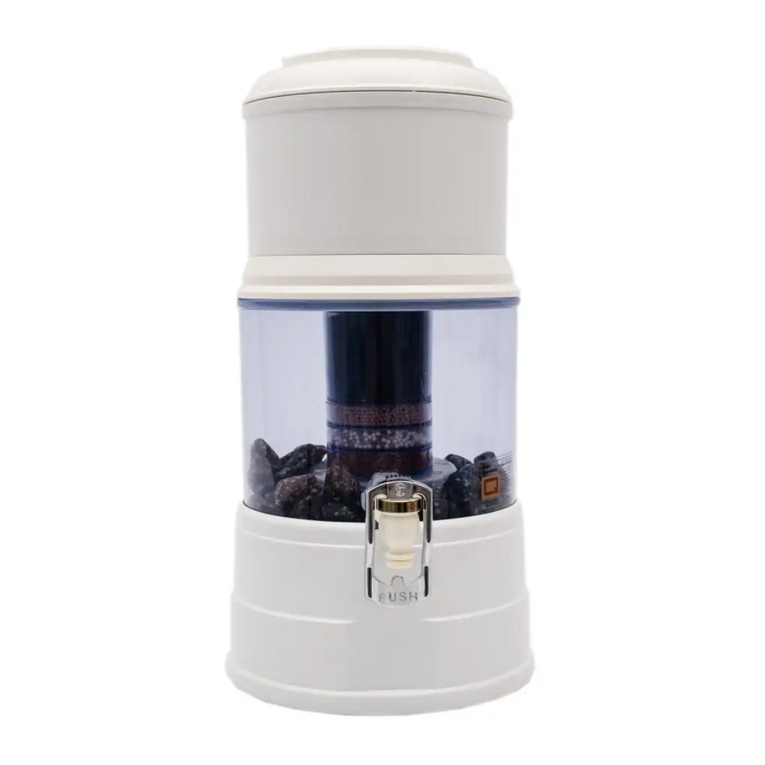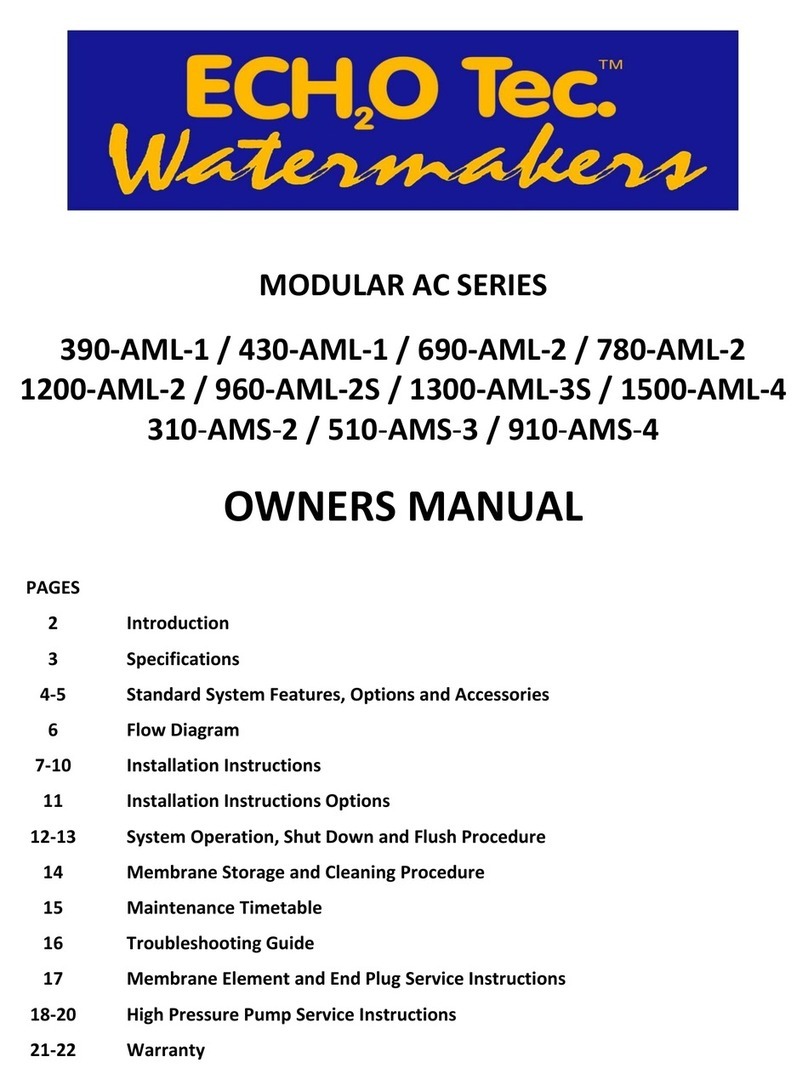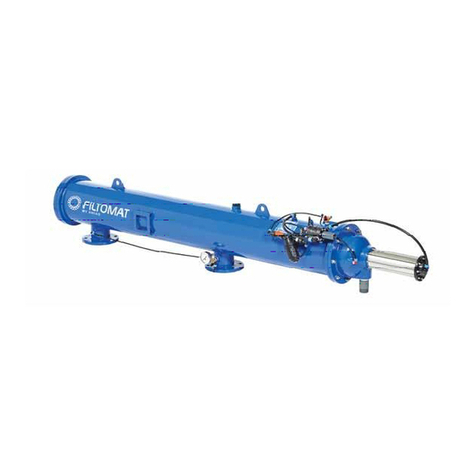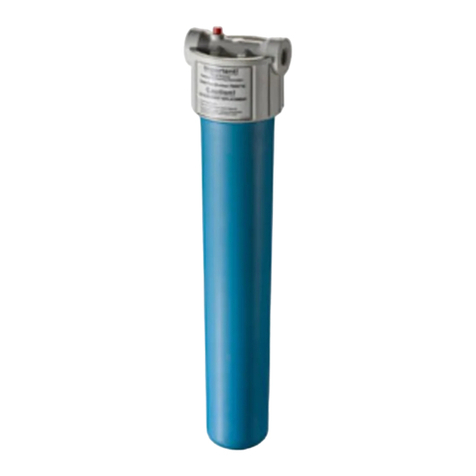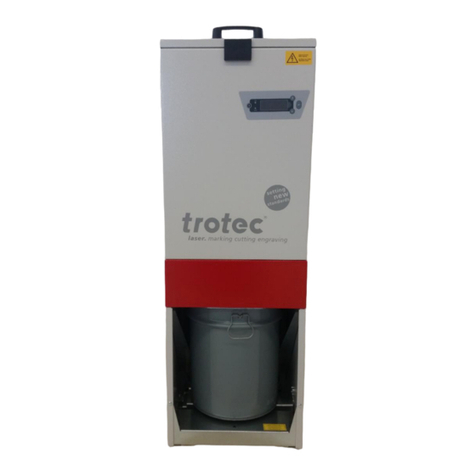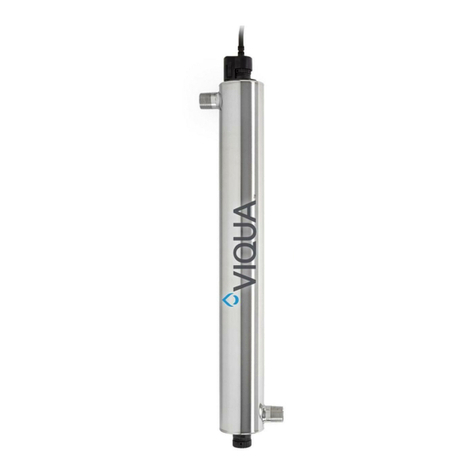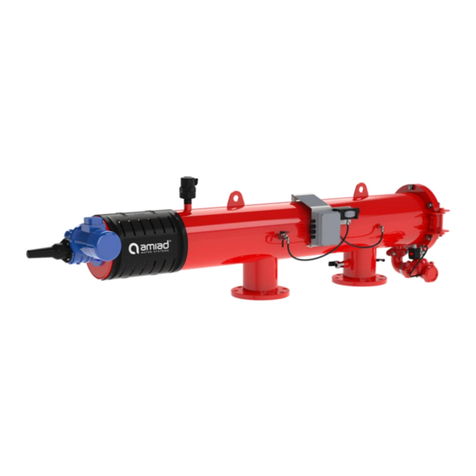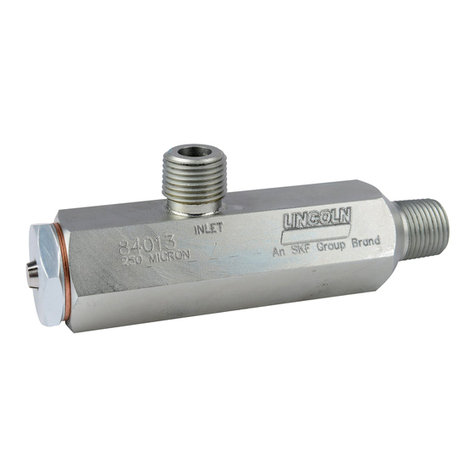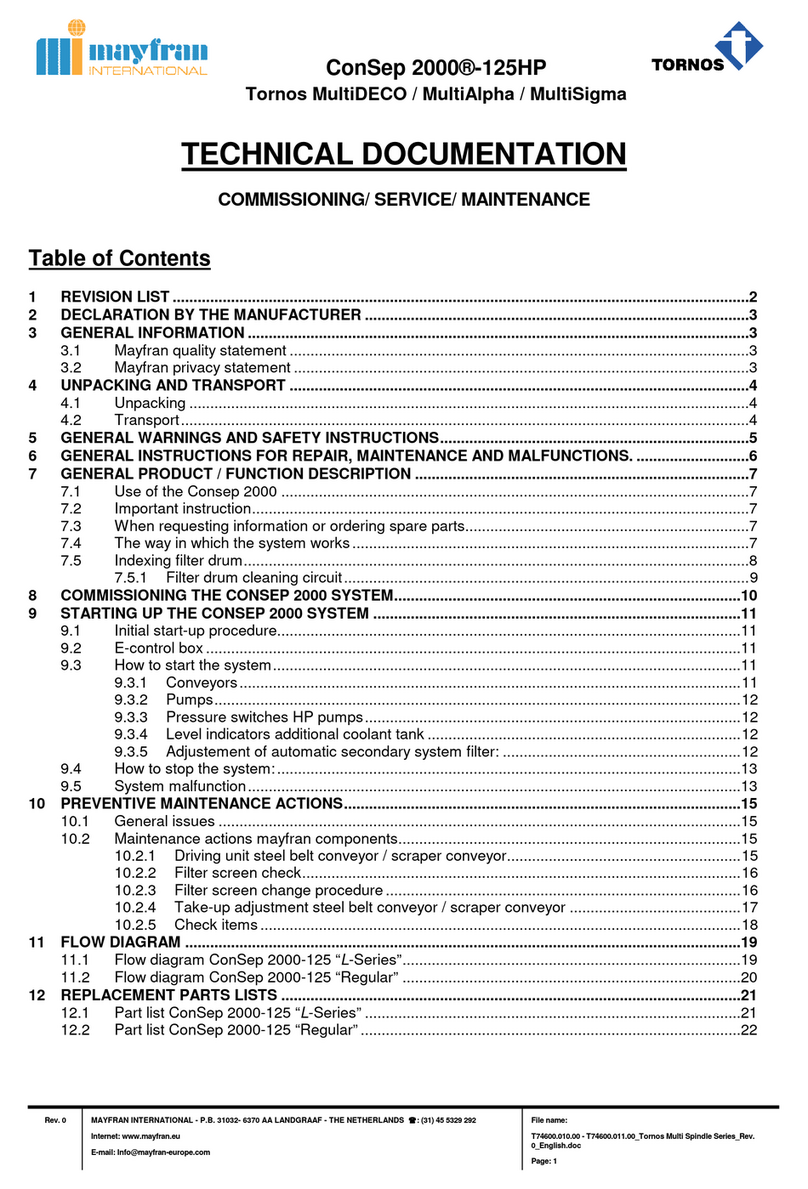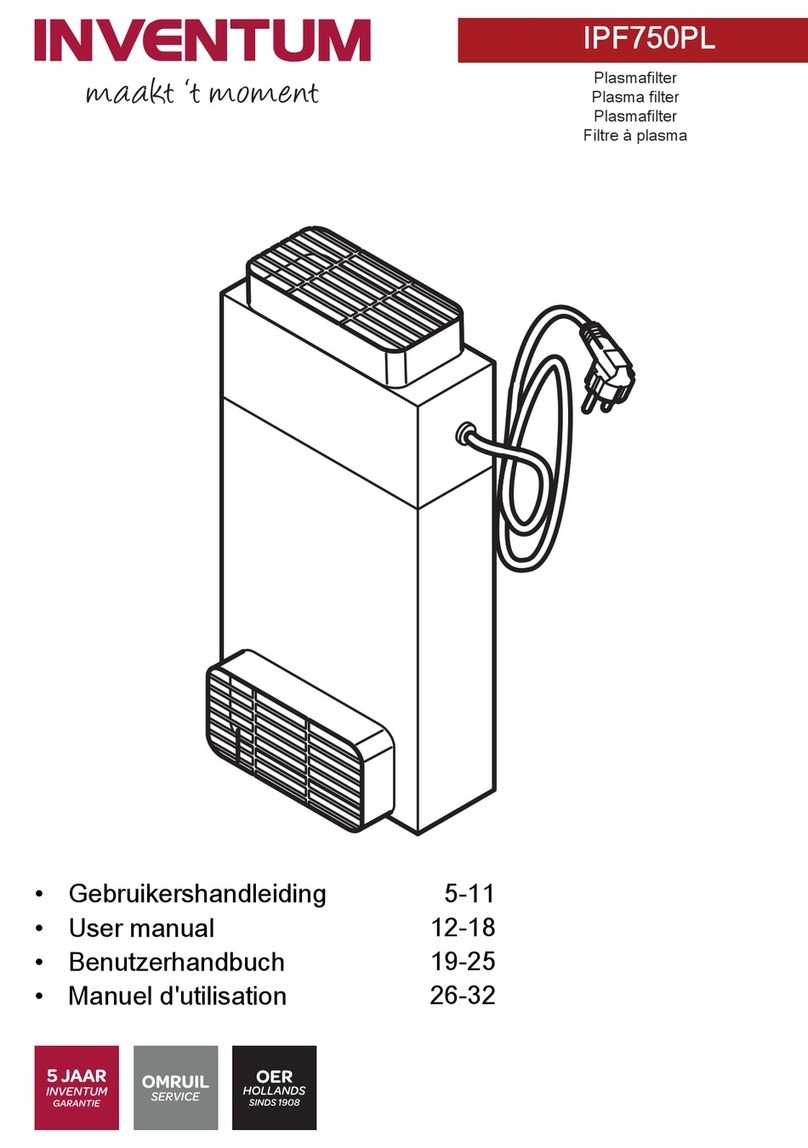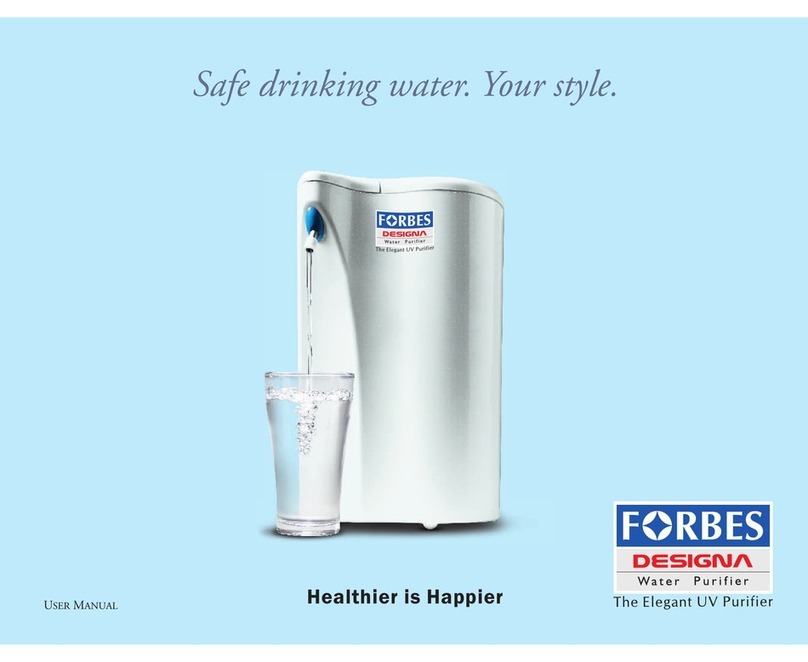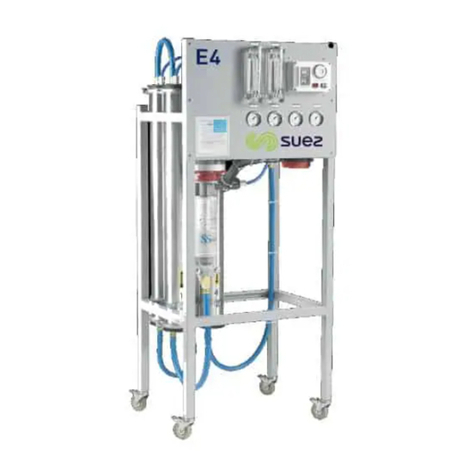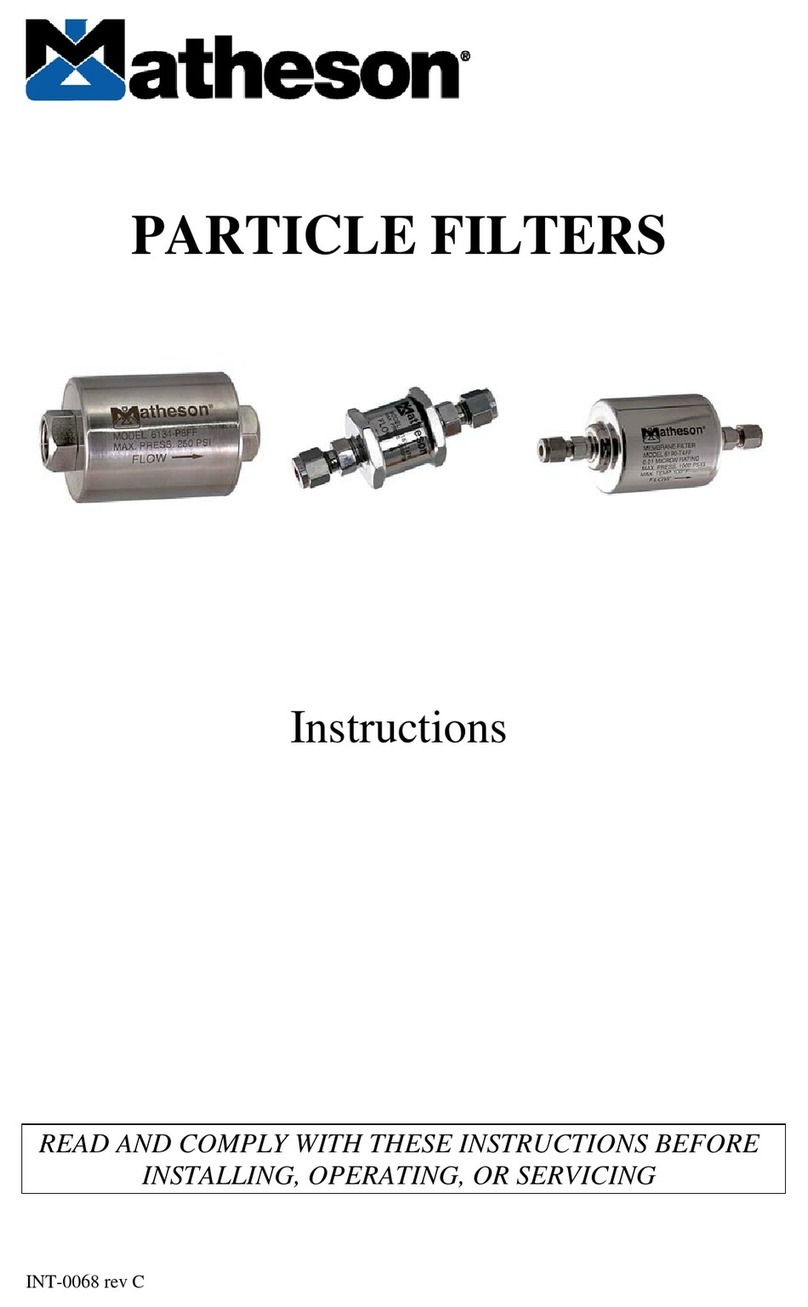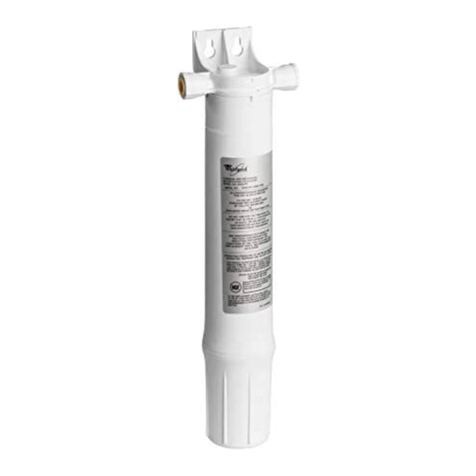Spasciani 100 Series User manual

SPASCIANI SPA
Via Saronnino, 72
21040 ORIGGIO (VARESE), ITALY
Tel. +39 - 02-9695181 -Fax +39 - 02-96730843
info@spasciani.com - www.spasciani.com
IT ISTRUZIONI PER L'USO
FILTRI SERIE 100 CON RACCORDO FILETTATO NORMALIZZATO
GENERALITÀ
Un dispositivo filtrante è costituito da un facciale (maschera
intera, semimaschera) collegato ad un filtro antigas, antipolvere
o combinato e depura l'aria inspirata da gas, vapori, polveri,
nebbie, fumi dannosi per la salute in essa eventualmente presenti.
I limiti di impiego derivano dal tipo di filtro, di facciale e dalle
condizioni ambientali. Le informazioni che seguono vanno
integrate con la legislazione nazionale vigente e con le istruzioni
specifiche dei dispositivi di protezione a cui i filtri vanno collegati.
I dispositivi filtranti sono DPI di III categoria (Regolamento (UE)
2016/425) e devono essere utilizzati solo da persone addestrate
e al corrente dei limiti di legge. La garanzia e la responsabilità del
produttore decadono in caso di uso improprio, di manomissione e
dalla non osservazione delle indicazioni qui riportate. Quanto
sopra non modifica le dichiarazioni relative a garanzie e
condizioni di vendita e consegna, non trattate in questo manuale.
FILTRI ANTIGAS, ANTIPOLVERE E COMBINATI
I filtri sono contraddistinti da un colore e da una sigla a seconda
della protezione da essi fornita conformemente alle norme EN
14387:2004+A1:2008 (antigas e combinati) e EN
143:2000/A1:2006 (antipolvere).
Filtri antigas: offrono protezione da gas e vapori nocivi
Filtri antipolvere: offrono protezione da polveri nocive
Filtri combinati: offrono protezione contemporaneamente da gas
e polveri nocive.
I filtri sono contrassegnati secondo il loro campo di applicazione
per tipo, a mezzo di lettere e colori distintivi, e in classe, a mezzo
di numeri. Di seguito sono riportate le tabelle che descrivono i
tipi di filtri antigas e le relative concentrazioni di impiego
consentite e i tipi di filtri antipolvere e la relativa capacità
filtrante.
Le prestazioni minime dei filtri antipolvere, antigas e combinati
previste dalle norme applicabili sono quelle previste dalle norme
relative e riassunte nelle seguenti tabelle:
I modelli di filtri per cui si applica la presente nota informativa
sono elencati nella Tab.5.
SELEZIONE DEI DISPOSITIVI DI PROTEZIONE DELLE VIE
RESPIRATORIE
La Tab. 3 riporta il Fattore di Protezione Nominale (FPN) e quello
Assegnato (FPA) relativi ai vari dispositivi e riferiti ad alcuni paesi
europei. L’FPA moltiplicato per il TLV della sostanza da un’idea
della concentrazione limite alla quale ci si può esporre con un
determinato dispositivo. Nell'uso dei filtri antigas, non superare
le concentrazioni indicate in Tab.1. Per la selezione e la
manutenzione dei dispositivi a filtro, per le definizioni e per l’uso
degli FPA fare riferimento alla norma europea EN 529:2005 e alle
relative regolamentazioni nazionali.
AVVERTENZE
•I filtri devono essere conservati sigillati alle condizioni di
temperatura e umidità indicate su etichetta e imballo e
possono essere posti in uso sino alla scadenza indicata.
•Scegliere il filtro correttamente facendo attenzione al colore e
alla sigla di identificazione. Un filtro antigas non protegge da
polveri e un filtro antipolvere non protegge da gas.
•Il filtro prescelto deve essere sempre collegato ad una
maschera intera (EN 136) o semimaschera (EN 140) dotate di
raccordo filettato normalizzato EN 148-1.
•Non utilizzare respiratori a filtro:
-se la natura del gas e/o la sua concentrazione sono
sconosciute
-in ambienti potenzialmente esplosivi (Zone 0 e 20)
-in atmosfere arricchite di ossigeno
-dove il tenore di ossigeno è inferiore al 17%* in vol. e in
ambienti chiusi (serbatoi, pozzi, containers, ecc.) (*valori
soggetti a regolamentazioni nazionali).
•Non utilizzare in presenza di monossido di carbonio o
comunque di gas inodori e insapori.
•Persone con il senso olfattivo alterato non devono utilizzare
respiratori a filtro. Lo stesso dicasi di persone con barba,
perché quest'ultima impedisce la corretta tenuta del facciale
sul viso.
•In lavori con fiamme libere od in presenza di schizzi di metallo
fuso l’uso di dispositivi di protezione con filtri antigas e
combinati potrebbe presentare rischi per l’operatore.
•Abbandonare la zona di lavoro qualora il filtro o il facciale
siano stati danneggiati e se si presentano difficoltà nella
respirazione e/o malori.
USO
Prima dell'uso:
- Leggere attentamente la presente nota informativa.
- Verificare che il filtro sia quello adeguato all’uso previsto,
controllando il tipo e la classe riportata sull'etichetta.
- Verificare l'integrità del filtro: agitare il filtro per assicurarsi che
i componenti non si siano staccati. Verificare la presenza di danni
o segni di colpi e che l'involucro protettivo sia intatto.
- Verificare la data di scadenza.
Se il filtro risulta danneggiato o scaduto non deve essere
utilizzato.
Uso:
- Togliere l'involucro protettivo solo poco prima del primo utilizzo.
- Avvitare manualmente in maniera salda il filtro al raccordo
filettato della maschera.
- Indossare il facciale e controllare la sua tenuta sul viso (inspirare
profondamente coprendo con il palmo della mano il filtro, la
maschera deve aderire perfettamente al viso senza perdite; per
ulteriori informazioni sulla prova di tenuta riferirsi alle istruzioni
per l'uso del facciale utilizzato).
DURATA
Non è possibile stabilire a priori la durata dei filtri poiché tale
periodo di tempo può variare a causa dalla natura e dalla
concentrazione della sostanza nociva, del ritmo respiratorio
dell'utilizzatore, dalla temperatura e dall'umidità dell'aria. I filtri
antigas vanno sostituiti al più tardi quando si comincia a
percepire l’odore o il gusto della sostanza nel facciale. I filtri
antipolvere vanno sostituiti quando la resistenza respiratoria
diventa troppo alta. I filtri combinati vanno sostituiti quando si
percepisce l'odore o il gusto del gas e/o la respirazione diventa
troppo difficoltosa.
MANUTENZIONE, IMMAGAZZINAMENTO, TRASPORTO
•Dopo l'utilizzo in condizioni normali, il filtro può essere
conservato in un sacchetto e immagazzinato alle condizioni

Pag. 2di 4
consigliate per un successivo riutilizzo. Sostituire comunque i
filtri entro sei mesi dalla data di apertura, anche se non
utilizzati. Segnare sempre sul corpo del filtro la data di
apertura.
•Il filtro non deve essere pulito, non deve essere sottoposto a
manutenzione né essere riparato. Non cercare mai di pulire il
filtro con aria compressa o acqua.
•I filtri vanno conservati in luoghi freschi e asciutti alle
condizioni di temperatura e umidità consigliati dal
Fabbricante, nelle confezioni originali; l'immagazzinaggio fatto
in condizioni diverse da quelle consigliate può compromettere
la durata di conservazione del filtro.
•La data di scadenza oltre alla quale non si può più usare il filtro
è sempre indicato sul filtro stesso e sulla sua confezione (5
anni).
•I filtri vanno smaltiti secondo le regolamentazioni nazionali
vigenti. I filtri P, A e AX sono rifiuti normali se non utilizzati ma
diventano speciali se utilizzati per filtrare sostanze pericolose.
Tutti gli altri filtri antigas e combinati sono sempre rifiuti
speciali (anche se non utilizzati).
•I filtri nel loro imballaggio originale non richiedono cure
particolari per il trasporto.
MARCATURA E CERTIFICAZIONI
Sull’etichetta del filtro sono riportate le seguenti informazioni
(per la spiegazione dei simboli e dei pittogrammi utilizzati vedi la
Tab.4):
-Marchio del fabbricante, Modello, Tipo, Classe e codice
prodotto, Norma di riferimento, Numero del lotto di
produzione, Pittogramma per data di scadenza, Pittogrammi
per un corretto immagazzinamento, Pittogramma “Vedere le
istruzioni per l’uso”.
-Marcatura CE che indica il rispetto dei requisiti essenziali di
cui all'All. II del Regolamento 2016/425/UE. Il numero 0426
identifica l'Organismo Notificato Italcert S.r.l., Viale Sarca 336,
20126 Milano - Italia, preposto al controllo della produzione
secondo il Modulo D del Regolamento 2016/425/UE e
coinvolto nella procedura di certificazione CE secondo il
Modulo B del Regolamento 2016/425/UE.
DICHIARAZIONE DI CONFORMITÀ
La dichiarazione di conformità UE è disponibile al sito internet
www.spasciani.com nella sezione Download per il prodotto di
proprio interesse.
EN INFORMATION NOTICE
100 SERIES FILTERS WITH STANDARD THEREAD CONNECTION
GENERAL
A filtering device consists of a facepiece (full-face mask, half
mask) connected to a gas, particle or combined filter and purifies
the inhaled air from gases, vapors, dusts, mists, fumes harmful to
health that may be present in it. The operating limits depend on
the type of filter, facepiece and environmental conditions. The
following information must be integrated with the national
legislation and with the specific instructions of the protective
devices to which the filters are to be connected. The filtering
devices are PPE of complex design (Regulation 2016/425/EU) and
must be used only by trained people and aware of the legal limits.
The warranty and responsibility of the manufacturer are avoided
if the product is not used and serviced in accordance with the
instructions in this manual.
The above does not alter statements regarding the warranties
and conditions of sale and deliveries, which have not been
mentioned in this manual.
GAS, PARTICLE AND COMBINED FILTERS
Filters are differentiated by a colour and a digit indicating the
protection provided according with the EN 14387:2004+A1:2008
(gas and combined filters) and EN 143:2000/A1:2006 (particle
filters) standards.
Gas filters: Offer protection against harmful gases and vapours
Particle filters: Offer protection against harmful particles and
aerosol
Combined filters: Offer protection against harmful gases,
particles and aerosols.
Filters are marked, according to their scope, through letters and
colours indicating their type and through numbers indicating
their class. Below are the tables that describe the types of gas
filters and their permitted concentrations of use and the types of
particle filters and their filtering capacity. The minimum
performances offered by filters are those provided by the relative
standards and summarized in the following tables:
Filter models for which this information note is applied are
listed in Tab. 5.
GUIDE TO THE SELECTION OF FILTER RESPIRATORS
Tab. 3 lists the values of the Nominal Protection Factors (NPF)
and of the Assigned Protection Factor (APF) gives from some
European countries to different respiratory protection
equipment. This value multiplied by the TLW of the substance
gives an idea of the concentration of pollutants to which an
operator can be exposed with a specific RPD. In the use of gas
filters do not exceed the concentrations listed in Table 1.
For the selection and maintenance, for definitions and use of APF
also refer to European standard EN 529:2005 and relevant
national regulations.
WARNINGS AND LIMITATIONS
•Filters kept sealed and at the temperature and humidity
conditions indicated on the label and on the packaging will last
till the date stamped on each of them.
•Chose the right filter for the intended use paying attention to
the colour and the identification marking. A gas filter does not
protect against particle and a particle filter does not protect
against gas.
•The chosen filter must always be connected to a full-face mask
(EN 136) or half mask (EN 140) equipped with a standard
threaded connection according to EN 148-1
•Do not use filtering respirator:
-If the nature or the concentration of the gas are not
known
-in potentially explosive areas (Zones 0 and 20)
-in oxygen-enriched atmospheres
-if the atmosphere contains at least 17%* in volume of
oxygen. This is unlikely to happen in confined spaces
(tanks, wells, containers, etc) (*these limits follow national
regulations)
•Do not use in the presence of carbon monoxide or in any case
of odourless and tasteless gases.
•Persons whose olfactory sense is altered shall not use filter
respirators. The same applies to people with beards, which
hinder the air tightness on the face.
•Please be aware of danger deriving by use of filter in the
presence of flames or splashes of molten metals because
charcoal contained in the filter may take fire or set toxic
substances free.
•Leave contaminated area in case of the following: you smell,
taste or are irritated by the contaminant; breathing becomes
difficult; dizziness or distress.

Pag. 3di 4
USE
Before use:
- Read this information notice carefully.
- Check if the coding of the filter is the correct one for the intended
use, looking at the label with color code, type and class.
- Check the integrity of the filter: shake the filter to make that
there are no loose components. Check for damage or signs and
that the case is undamaged.
- Check the expiry date.
If the filter is damaged or expired must not be used.
Use:
- Remove the packaging, the seal and / or the filter cap shortly
before use.
- Screw the filter tight into the screw thread of the facepiece.
- Don the respirator and then check the face seal (inhale deeply
covering the filter with the palm of the hand, the mask must fit
perfectly to the face without loss; for further information on the leak
test refer to the instructions for the use of the related facepiece).
DUTY PERIOD OF USE
A general guide to duty periods cannot be given, as the duty
period depends very heavily on the ambient conditions, e. g.
nature and concentration of the contaminants, breathing rate of
the user, humidity and temperature. Gas filters must be replaced
at the latest when you start to smell or taste the gas inside the
facepiece. Particle filters must be replaced when an increase in
breathing resistance is felt. Combined filters must be replaced
when you start to smell or taste the gas and/or an increase in
breathing resistance is felt.
MAINTENANCE, STORAGE, TRANSPORT
•After use under normal conditions, the filter can be stored in
a bag under recommended conditions for subsequent re-use.
Replace the filters anyway within six months of the opening
date, even if not used. Always mark the opening date on the
filter body.
•The filter must not be cleaned, reconditioned or repaired.
Never clean the filters with compressed air or compressed
water.
•The filters must be stored in cool and dry places at the
temperature and humidity conditions recommended by the
manufacturer, in their original packaging; storage done under
conditions other than those recommended may compromise
the life of the filter.
•The expiry date of the filter is indicated on the filter itself and
on the packaging (5 years).
•Dispose of respiratory filters as hazardous waste in accordance
with the applicable local waste disposal regulations. P, A and
AX filters are normal waste if not used but become special if
used to filter hazardous substances. All other gas and
combined filters are always special waste (even if not used)
and must be disposed according to the substances retained
and local legislation.
•Filters stored in their original packaging do not require any
particular care for their transportation.
MARKING AND APPROVALS
The following information are quoted on the filter label (for the
explanation of the symbols and pictograms used see Tab. 4).
-Manufacturer trade mark, Model, type, class and P/N,
Reference standards, Batch number, Pictogram with expiry
date, Pictogram indicating correct storage condition,
Pictogram "See the instructions for use”.
-CE marking which indicates compliance with the essential
requirements listed in Annex II of Regulation (EU) 2016/425.
The number 0426 identifies the notified body Italcert S.r.l.,
Viale Sarca 336, 20126 Milan - Italy - that carries out the
manufacturing control according to Module D of Regulation
2016/425/EU and involved in the product certification in
accordance with Module B of Regulation 2016/425/EU.
DECLARATION OF CONFORMITY
The EU declaration of conformity is available on the website
www.spasciani.com in the Download section of the product of
interest.
Tab. 1 - Tipi di filtri contro gas e polveri / Types of gas and particle filters
Tipo
Type
Codice colore /
Colour code
Campo d'impiego /
Field of application
Classe
/Class
Massima conc. gas
consentita / Max perm.
conc
A
Marrone
Brown
Gas e vapori organici con punto di ebollizione >65°C /
Organic gases and vapors with boiling point > 65 °C
1
2
1000 ml/m3(0.1% Vol.)
5000 ml/m3(0.5% Vol.)
AX
Marrone
Brown
Gas e vapori organici con punto di ebollizione <65°C /
Organic gases and vapors with boiling point < 65 °
1
2
1000 ml/m3(0.1% Vol.)
5000 ml/m3(0.5% Vol.)
B
Grigio
Grey
Gas e vapori inorganici / Inorganic gas and vapours
1
2
1000 ml/m3(0.1% Vol.)
5000 ml/m3(0.5% Vol.)
E
Giallo
Yellow
Gas acidi / Acid Gases
1
2
1000 ml/m3(0.1% Vol.)
5000 ml/m3(0.5% Vol.)
K
Verde
Green
Ammoniaca / Ammonia
1
2
1000 ml/m3(0.1% Vol.)
5000 ml/m3(0.5% Vol.)
P
Bianco
White
Polveri, fumi, nebbie / Dusts, fumes and mists
1,2 o 3
-
Tab. 2a –Capacità di protezione ai gas / Protection against gases
Tipo di filtro e classe
/ Filter type and
class
Gas di prova / Gas
Test
Conc. gas prova / Gas test
conc. (% vol.)
Conc. rottura /
Breakthrough conc.
(ml/m3)
Tempi rottura min. /
Min Breakthrough
time (min)
A1 / A2
C6H12
0.1 / 0.5
10 / 10
70 / 35
B1 / B2
Cl2
0.1 / 0.5
0.5 / 0.5
20 / 20

Pag. 4di 4
Tab. 2b –Efficienza filtrante polveri / Filtering efficiency against particle
Classe filtro /
Filter class
Max penetrazione del filtro
Maximum filter penetration (%)
NaCl
Paraffin oil
P1 / P2 / P3
20 / 6 /0.05
20 /6 / 0.05
Tab.3 - FPA e FPN in vari paesi / - APF and NFP in different countries
Norma /
Standard
Apparecchiatura filtrante / Type of RPD
Classe /
Class
NFP
APF
FIN
D
I
S
UK
EN 140
Semimaschera
Half mask
P2
10
10
10
10
10
10
P3
20
--
30
30
--
20
Gas
20
20
30
30
20
10
GasXP3
20
--
30
--
--
10
EN 136
Maschera intera
Full face mask
P2
10
15
15
15
15
10
P3
1000
500
400
400
50
40
Gas
2000
500
400
400
500
20
GasXP3
1000
400
--
20
Tab.4 - Marcature, simboli, pittogrammi / Marking, symbols, pictograms
Intervallo di temperatura per le
condizioni di immagazzinamento /
Storage temperature range
Percentuale massima di umidità (RH) per condizioni
di immagazzinamento / Maximum storage humidity
(RH)
Anno (aaaa) e mese (mm) della
scadenza del filtro / Expiry date,
year (aaaa) and month (mm)
Richiamo a leggere le presenti istruzioni per l'uso /
Read the attached use and maintenance
handbook
EN 14387:2004+A1:2008
EN 143:2000/A1:2006
Norme di riferimento /
Reference standards
R
NR
La marcatura "R" indica che il filtro antipolvere o la
parte antipolvere di un filtro combinato può essere
riutilizzata per più di un turno di lavoro dopo
l’esposizione ad un aerosol; la marcatura NR indica
che l’uso è limitato ad un solo turno di lavoro.
The marking with the letter "R" shows that the
particle filter or the particle filtering part of a
combined filter is reusable after aerosol exposure for
more than one shift, “NR” marking indicates that use
shall be limited to a single shift.
Tab. 5 –Modelli filtri serie 103 / 103 series filters models
Nome Filtro /
Filter description
Codice /
P/N
Tipo Filtro /
Filter type
Tipo di raccordo /
Thread type
103 A1P3 R
114180000
Combinato/Combined
EN 148-1
103 A1B1E1K1P3 R
114190000
Combinato/Combined
EN 148-1
SPASCIANI S.p.A.
Via Saronnino, 72 - 21040 Origgio (VA) –Italy
www.spasciani.com
Cod. 960191000 rev.1 - it en
H2S
HCN
0.1 / 0.5
0.1 / 0.5
10 / 10
10 / 10
40 / 40
25 / 25
E1 / E2
SO2
0.1 / 0.5
5 / 5
20 / 20
K1 / K2
NH3
0.1 / 0.5
25 / 25
50 / 40
This manual suits for next models
4
